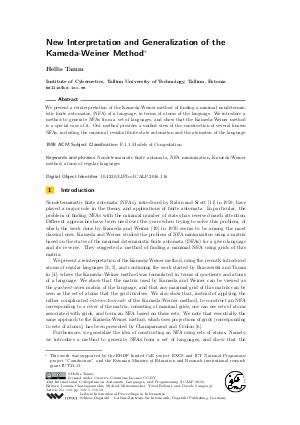New Interpretation and Generalization of the Kameda-Weiner Method
Author Hellis Tamm
-
Part of:
Volume:
43rd International Colloquium on Automata, Languages, and Programming (ICALP 2016)
Part of: Series: Leibniz International Proceedings in Informatics (LIPIcs)
Part of: Conference: International Colloquium on Automata, Languages, and Programming (ICALP) - License:
 Creative Commons Attribution 3.0 Unported license
Creative Commons Attribution 3.0 Unported license
- Publication Date: 2016-08-23
File

PDF
LIPIcs.ICALP.2016.116.pdf
- Filesize: 429 kB
- 12 pages
Document Identifiers
Subject Classification
Keywords
- Nondeterministic finite automata
- NFA minimization
- Kameda-Weinermethod
- atoms of regular languages
Metrics
- Access Statistics
-
Total Accesses (updated on a weekly basis)
0PDF Downloads0Metadata Views
Abstract
We present a reinterpretation of the Kameda-Weiner method of finding a minimal nondeterministic finite automaton (NFA) of a language, in terms of atoms of the language. We introduce a method to generate NFAs from a set of languages, and show that the Kameda-Weiner method is a special case of it. Our method provides a unified view of the construction of several known NFAs, including the canonical residual finite state automaton and the atomaton of the language.
Cite As Get BibTex
Hellis Tamm. New Interpretation and Generalization of the Kameda-Weiner Method. In 43rd International Colloquium on Automata, Languages, and Programming (ICALP 2016). Leibniz International Proceedings in Informatics (LIPIcs), Volume 55, pp. 116:1-116:12, Schloss Dagstuhl – Leibniz-Zentrum für Informatik (2016)
https://doi.org/10.4230/LIPIcs.ICALP.2016.116
BibTex
@InProceedings{tamm:LIPIcs.ICALP.2016.116,
author = {Tamm, Hellis},
title = {{New Interpretation and Generalization of the Kameda-Weiner Method}},
booktitle = {43rd International Colloquium on Automata, Languages, and Programming (ICALP 2016)},
pages = {116:1--116:12},
series = {Leibniz International Proceedings in Informatics (LIPIcs)},
ISBN = {978-3-95977-013-2},
ISSN = {1868-8969},
year = {2016},
volume = {55},
editor = {Chatzigiannakis, Ioannis and Mitzenmacher, Michael and Rabani, Yuval and Sangiorgi, Davide},
publisher = {Schloss Dagstuhl -- Leibniz-Zentrum f{\"u}r Informatik},
address = {Dagstuhl, Germany},
URL = {https://drops.dagstuhl.de/entities/document/10.4230/LIPIcs.ICALP.2016.116},
URN = {urn:nbn:de:0030-drops-62518},
doi = {10.4230/LIPIcs.ICALP.2016.116},
annote = {Keywords: Nondeterministic finite automata, NFA minimization, Kameda-Weinermethod, atoms of regular languages}
}
Author Details
References
-
J. Brzozowski. Canonical regular expressions and minimal state graphs for definite events. In Proceedings of the Symposium on Mathematical Theory of Automata, volume 12 of MRI Symposia Series, pages 529-561. Polytechnic Press, Polytechnic Institute of Brooklyn, N.Y., 1963.

-
J. Brzozowski and S. Davies. Quotient complexities of atoms in regular ideal languages. Acta Cybernetica, 22(2):293-311, 2015.

-
J. Brzozowski and H. Tamm. Theory of átomata. In G. Mauri and A. Leporati, editors, Proceedings of the 15th International Conference on Developments in Language Theory (DLT ), volume 6795 of Lecture Notes in Computer Science, pages 105-116. Springer, 2011.

- J. Brzozowski and H. Tamm. Minimal nondeterministic finite automata and atoms of regular languages, 2013. URL: http://arxiv.org/abs/1301.5585.
-
J. Brzozowski and H. Tamm. Theory of átomata. Theor. Comput. Sci., 539:13-27, 2014.

-
J.-M. Champarnaud and F. Coulon. Enumerating nondeterministic automata for a given language without constructing the canonical automaton. Int. J. Found. Comput. Sci., 16:1253-1266, 2005.

-
F. Denis, A. Lemay, and A. Terlutte. Residual finite state automata. Fund. Inform., 51:339-368, 2002.

-
H. Gruber and M. Holzer. Finding lower bounds for nondeterministic state complexity is hard. In Proc. of DLT 2006, volume 4036 of Lecture Notes in Computer Science, pages 363-374. Springer, 2006.

-
S. Iván. Complexity of atoms, combinatorially. Information Processing Letters, 116:356-360, 2016.

-
T. Kameda and P. Weiner. On the state minimization of nondeterministic finite automata. IEEE Trans. Comput., C-19(7):617-627, 1970.

-
M. Rabin and D. Scott. Finite automata and their decision problems. IBM J. Res. and Dev., 3:114-129, 1959.

-
H. Sengoku. Minimization of nondeterministic finite automata. Master’s thesis, Kyoto University, Department of Information Science, Kyoto University, Kyoto, Japan, 1992.

-
H. Tamm. Generalization of the double-reversal method of finding a canonical residual finite state automaton. In Proceedings of DCFS 2015, volume 9118 of LNCS, pages 268-279. Springer, 2015.

